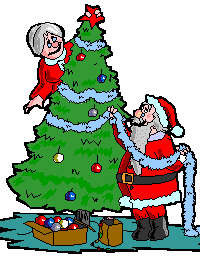

![]()

The traditional Christmas is not a single day, but spans a
couple of them, normally from 24th December to 6th January. This
prolonged period includes the New Year, which increases the festival
value of Christmas. Modern festivities also include Hannakuh and
Kwanzaa, which for the season of 1997 fell in with the time of
Christmas. Hannakuh lasted from December 24th to December 31st
that year, while Kwanzaa was from December 26th to January 1st,
1998.
Christmas is usually a celebration of the birth of Jesus Christ.
Born nearly two thousand years ago, Christians believe Him to
be the Son of God. Whether Jesus was really born on December 25th,
no one knows. The date was chosen because it already was
a holiday in ancient times - the pagan festival of Saturnalia
(which goes even further back. Saturnalia was a festival
worshiping the sun god Ra in ancient Rome). But the pagans did
not believe in Jesus.
Around the third century there was an attempt to fix the day of His birth by celebrating it during the Nativity festival kept in Rome during the reign of Bishop Tilesphorus (between A.D. 127 and 139). Some Christmas observances of the Roman Church are said to be of Bishop Tilesphorus appointment. There was the Nativity between A.D. 161 and 180 but the exact year, again, is not known. In A.D. 300, a similar event is said to have taken place at Nicomedia in the reign of Diocletian. Neither of these stories seem reliable as a measure of the day Christ was born, however, because at the time of these festivals, Jesus had come and gone.
![]()


Hannakkuh (Chunakuh), the Festival of Lights, is celebrated for
eight days, starting the 25th day of the month of Kislev (November/December).
The purpose of this holiday is to celebrate the victory of the
Jews over the Hellenist Syrians in 165 BCE. (Modern dates change
with the Jewish Calendar.)
Following this victory, the Maccabees, sons of the Priestly
Hasmonean family, entered the Holy Temple in Jerusalem (which
had been defiled by Syrian invaders), with the purpose of cleansing
it and rededicating it to the service of God. Then, in memory
of their victory, the Maccabees celebrated the first Hannakkuh.
(Hannakkuh is the Hebrew term for dedication.)
The Talmud, the body of Jewish oral law, explains how the Judean heroes, led by Judah Maccabee, were making ready to rededicate the Temple when they discovered they didn't have enough undefiled oil to light the lamps. However, in one of the Temple chambers, they finally came upon a small cruse of oil hidden away which should have lasted only one evening. Miraculously, this small amount of oil kept the Temple lights burning, not for one night, but for all eight nights until oil fit for Temple use could be found. This is the miracle of the Hannakuh lights.

Kwanzaa (Quansa) is a holiday celebrated by many African-Americans. It is held December 26th through January 1st every year. It was started in 1966 by Doctor Maulana Karenga, Professor at the California State University, Long Beach, California.
The seven day celebration encourages people to think about their African roots as well as their life in present day America. Kwanzaa is based on African festivals. The word means "the first fruits".
Umoja: (unity) to strive for and maintain unity in the family, community, nation and race.
Kujichagulia (self-determination) to define ourselves, name ourselves, create for ourselves and speak for ourselves.
Ujima (collective work and responsibility) to build and maintain our community together and make our sister's and brother's problems our problems and to solve them together.
Ujamaa (cooperative economics) to build and maintain our own stores, shops and other businesses together.
Nia (purpose) to make our collective vocation the building of our community to restore our people to their traditional greatness.
Kuumba (creativity) to do as much as we can to leave our community more beautiful and beneficial than we inherited it.
Imani (faith) to believe with our hearts in our people, our parents, our teachers, our leaders and the righteousness and victory of our struggle.
Black for the face of our people
Red for the blood our people shed
Green for the hope and the color of the motherland

